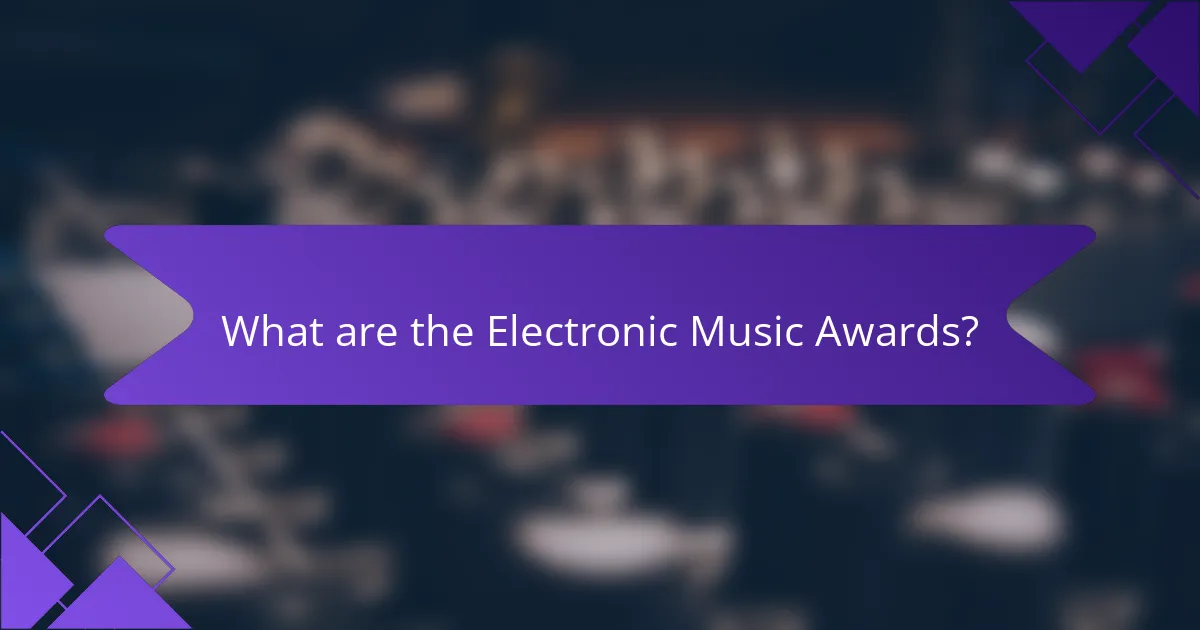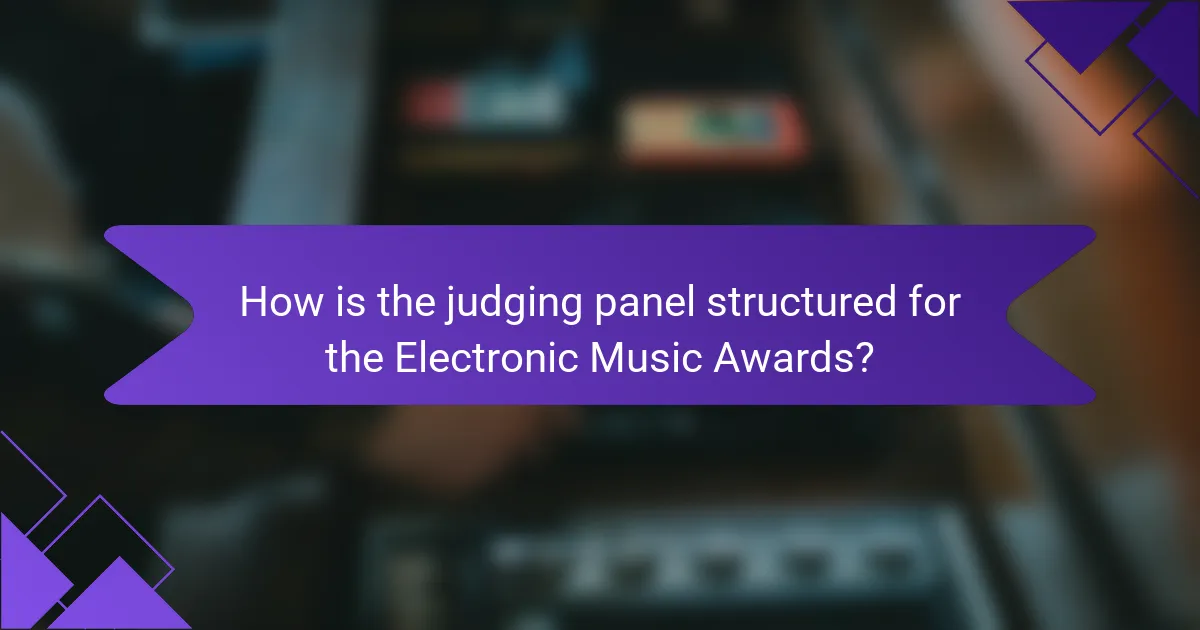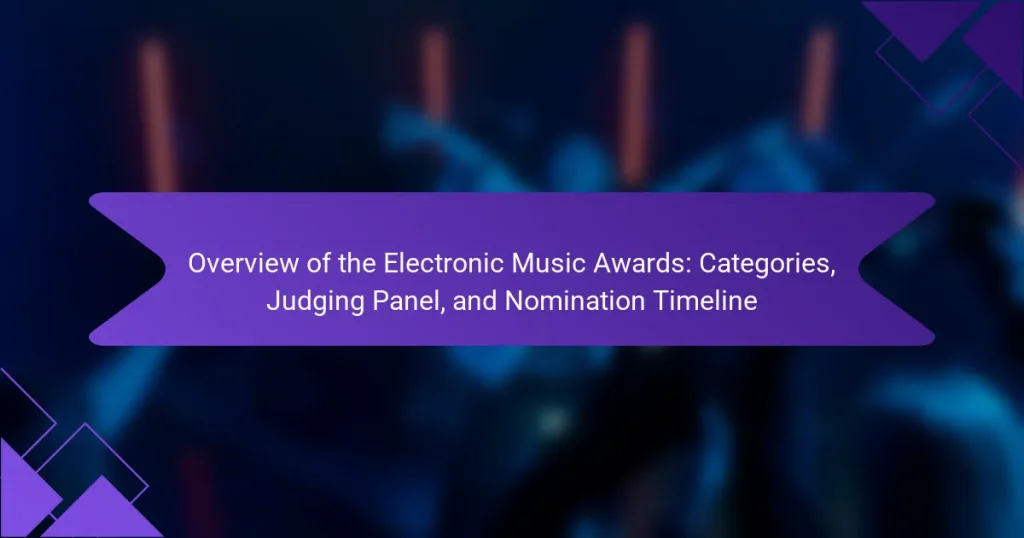The Electronic Music Awards are an annual event that honors achievements in the electronic music genre, celebrating both established and emerging artists across multiple categories. Key award categories include Best Artist, Best Album, Best Track, and Best New Artist, among others. The judging panel consists of industry professionals, including artists and producers, who evaluate nominations based on criteria such as innovation and impact. The nomination process typically involves public voting and expert selections, with timelines spanning from early summer to early fall for nominations and the subsequent awards ceremony. This structure ensures a comprehensive representation of the electronic music community and highlights exceptional contributions within the genre.

What are the Electronic Music Awards?
The Electronic Music Awards are an annual event recognizing achievements in electronic music. They celebrate various genres and artists within the electronic music scene. The awards encompass multiple categories, including Best Artist, Best Album, and Best Track. The event aims to honor both established and emerging talent. The first Electronic Music Awards took place in 2017. They feature a judging panel of industry professionals and artists. The nomination process typically involves public voting and expert selections. This ensures a comprehensive representation of the electronic music community.
How did the Electronic Music Awards originate?
The Electronic Music Awards originated in 2016 as a recognition platform for electronic music artists. The event aimed to celebrate achievements in the electronic music genre. Initially, it was established to honor artists, producers, and industry professionals. The inaugural ceremony took place in Los Angeles. The event featured various categories to encompass the diversity of electronic music. It sought to create a formal recognition system within the electronic music community. The awards have since evolved to include a wider range of genres and styles. The initiative reflects the growing influence of electronic music in the global music industry.
What was the motivation behind establishing the Electronic Music Awards?
The motivation behind establishing the Electronic Music Awards was to recognize and celebrate the achievements of electronic music artists. The awards aimed to provide a platform for artists in a genre that often lacked mainstream recognition. By honoring various categories within electronic music, the initiative sought to elevate the profile of the genre. The founders intended to create an annual event that would foster community engagement and appreciation. This was particularly important as electronic music continued to grow in popularity worldwide. The awards also aimed to inspire new talent by showcasing established artists. Ultimately, the Electronic Music Awards were designed to bring legitimacy and visibility to the electronic music scene.
Who were the key figures involved in the inception of the Electronic Music Awards?
The key figures involved in the inception of the Electronic Music Awards include Paul Oakenfold and DJ/producer Chris Lake. Paul Oakenfold is known for his influence in the electronic music scene. Chris Lake contributed his expertise as a prominent DJ and producer. Their collaboration aimed to recognize and celebrate achievements in electronic music. The awards were first held in 2016. They sought to bring together artists, fans, and industry professionals. The Electronic Music Awards highlighted various categories to honor talent in the genre.
What is the significance of the Electronic Music Awards in the industry?
The Electronic Music Awards hold significant importance in the industry as they recognize and celebrate achievements in electronic music. These awards highlight the contributions of artists, producers, and innovators within the genre. They also help to elevate the profile of electronic music on a global scale. By providing a platform for recognition, the awards encourage creativity and innovation in the field. The Electronic Music Awards foster community engagement among fans and industry professionals alike. They also serve as a benchmark for excellence and influence trends within the electronic music scene. The event garners media attention, increasing visibility for nominees and winners. Overall, the Electronic Music Awards play a crucial role in shaping the future of electronic music.
How do the Electronic Music Awards impact artists and producers?
The Electronic Music Awards significantly impact artists and producers by providing recognition and exposure. Winning or being nominated can enhance an artist’s credibility in the industry. It can lead to increased media attention and new opportunities for collaborations. The awards also often result in higher streaming numbers and sales for nominated works. Furthermore, the Electronic Music Awards promote networking among industry professionals. This networking can facilitate future projects and partnerships. Overall, the awards serve as a platform to elevate the profiles of electronic music creators. This elevation can have lasting effects on their careers and artistic endeavors.
Why are the Electronic Music Awards considered prestigious?
The Electronic Music Awards are considered prestigious due to their recognition of excellence in electronic music. They celebrate outstanding achievements across various genres and styles within the electronic music scene. The awards are judged by industry experts, including prominent artists and producers. This expert panel enhances the credibility of the awards. The event attracts significant media attention and participation from top talent in the industry. Additionally, winning an Electronic Music Award often leads to increased visibility and opportunities for nominees. The awards have a history of honoring influential figures, which adds to their prestige.

What categories are included in the Electronic Music Awards?
The Electronic Music Awards include categories such as Best Electronic Album, Best Dance Record, and Best New Artist. Additional categories are Best Live Act, Best DJ, and Best Music Video. These categories recognize various aspects of electronic music and its artists. Each category aims to highlight exceptional talent and contributions within the genre. The awards celebrate both established and emerging artists in the electronic music scene.
What are the main award categories?
The main award categories for the Electronic Music Awards include Best Electronic Album, Best Electronic Track, Best New Artist, Best DJ, and Best Live Performance. Each category recognizes excellence within the electronic music genre. Best Electronic Album honors outstanding full-length works. Best Electronic Track acknowledges individual tracks that have made significant impact. Best New Artist highlights emerging talent in the electronic music scene. Best DJ celebrates the skills and contributions of prominent DJs. Best Live Performance rewards exceptional live shows in electronic music.
Which genres are represented in the award categories?
The award categories represent various genres of electronic music. These genres include house, techno, drum and bass, and trance. Additionally, genres like dubstep, ambient, and electro are also recognized. Each genre showcases unique styles and influences within electronic music. This diversity reflects the broad spectrum of creativity in the electronic music scene.
How are the categories determined each year?
The categories for the Electronic Music Awards are determined annually through a comprehensive review process. This process involves analyzing trends in the electronic music industry. Key factors include genre popularity, emerging artists, and technological advancements. Industry experts and stakeholders contribute insights during this evaluation. A committee of professionals finalizes the categories based on these findings. The goal is to reflect the current landscape of electronic music. Categories are then announced ahead of the nomination timeline. This ensures relevance and inclusivity in the awards.
What are some unique categories in the Electronic Music Awards?
The Electronic Music Awards features unique categories such as Best Live Act, Best Breakthrough Artist, and Best Remix. Best Live Act honors outstanding performances by electronic artists. Best Breakthrough Artist recognizes newcomers making significant impacts in the genre. Best Remix awards excellence in reinterpreting existing tracks. Other unique categories include Best Album and Best Track, showcasing full works and individual songs respectively. These categories highlight the diversity and creativity within electronic music.
What distinguishes these unique categories from traditional ones?
Unique categories in the Electronic Music Awards focus on specific sub-genres and innovative styles. Traditional categories often encompass broader genres without such specialization. This distinction allows recognition of emerging trends and niche artists. Unique categories may include awards for best live performance or best collaboration in electronic music. Traditional categories typically do not highlight these aspects. The emphasis on innovation reflects the dynamic nature of electronic music. This approach encourages diversity and creativity in the industry.
How do these unique categories reflect current trends in electronic music?
Unique categories in electronic music awards reflect current trends by highlighting diverse sub-genres. These sub-genres represent the evolving soundscape of electronic music. For instance, categories like ‘Best Techno Track’ and ‘Best Future Bass’ showcase popular styles. The inclusion of ‘Best Live Performance’ emphasizes the growing importance of live shows. Additionally, categories focusing on emerging artists indicate a trend towards supporting new talent. This shift aligns with the rise of platforms like SoundCloud and Bandcamp, which promote independent artists. The awards also adapt to technological advancements, with categories like ‘Best Use of Technology in Music Production’. Overall, these categories capture the dynamic nature of the electronic music scene.

How is the judging panel structured for the Electronic Music Awards?
The judging panel for the Electronic Music Awards is composed of industry professionals. This includes artists, producers, and music executives. Each member brings expertise in electronic music. The panel evaluates nominations based on specific criteria. These criteria include innovation, creativity, and impact on the genre. The structure ensures a diverse range of perspectives. This diversity enhances the fairness of the judging process. The panel’s decisions are made collectively to maintain integrity.
Who comprises the judging panel for the Electronic Music Awards?
The judging panel for the Electronic Music Awards comprises industry professionals and artists. This includes record producers, DJs, and music executives. Their expertise spans various electronic music genres. The panel evaluates submissions based on creativity and innovation. Additionally, members are selected for their influence in the electronic music scene. The diverse backgrounds of judges ensure a comprehensive review process. This structure enhances the credibility of the awards.
What qualifications do judges need to have?
Judges need to have a law degree and relevant legal experience. Most judges have practiced law for several years before appointment. They often hold positions in the judicial system or have experience in litigation. Many jurisdictions require judges to be licensed attorneys. Additionally, judges may need to pass a judicial examination. Some judges are appointed based on merit, while others are elected. Continuing legal education is often required to maintain their qualifications. These qualifications ensure judges are knowledgeable and capable of making informed decisions in court.
How are judges selected for the panel?
Judges for the panel are selected based on their expertise in the electronic music industry. The selection process involves evaluating their professional background and contributions to the genre. Judges typically have experience as producers, DJs, or industry leaders. Their knowledge ensures a fair and informed judging process. The selection committee reviews potential judges for their credibility and influence. This rigorous evaluation aims to maintain high standards for the awards. Ultimately, the chosen judges reflect the diversity and creativity within the electronic music scene.
What is the judging process for the Electronic Music Awards?
The judging process for the Electronic Music Awards involves multiple stages. Initially, submissions are reviewed by a panel of industry experts. This panel evaluates entries based on criteria such as creativity, originality, and impact. The panelists score each submission individually. After scoring, the panel convenes to discuss the results. They reach a consensus on the nominees for each category. The final winners are determined through a combination of panel votes and public voting. This process ensures a fair and comprehensive evaluation of all entries.
How are nominations evaluated by the judges?
Nominations are evaluated by judges based on specific criteria set by the awards. These criteria include originality, creativity, production quality, and overall impact. Judges assess each nomination against these benchmarks to ensure fairness and consistency. They may also consider audience reception and the nominee’s contribution to the electronic music genre. Evaluation involves a scoring system where judges assign points to each criterion. The total score determines the nominees’ ranking. This structured approach ensures that the evaluation process is transparent and objective.
What criteria are used to determine the winners?
Winners of the Electronic Music Awards are determined based on several criteria. These criteria include artistic merit, innovation, and popularity among fans. The judging panel evaluates submissions for creativity and technical skill. Additionally, public voting influences the final results. Each category has specific guidelines that judges follow. Judges consider both the quality of the music and its impact on the electronic music scene. Transparency in the voting process is maintained to ensure fairness. This structured approach helps identify deserving winners in each category.

What is the nomination timeline for the Electronic Music Awards?
The nomination timeline for the Electronic Music Awards typically spans several months. Nominations usually open in early summer. They remain open for a specific period, often until late summer. The exact dates can vary each year. After nominations close, a judging panel reviews the submissions. The panel then selects the final nominees. This process culminates in an announcement in early fall. The awards ceremony usually takes place shortly after the nominees are revealed.
When does the nomination process begin and end?
The nomination process for the Electronic Music Awards begins on January 1st and ends on February 28th each year. This timeline allows artists and fans to submit nominations for various categories. The process is designed to ensure ample time for participation. It has been consistently followed in previous years, reinforcing its reliability.
What are the key dates to remember during the nomination timeline?
The key dates to remember during the nomination timeline for the Electronic Music Awards include the nomination opening date, which is typically in early January. Nominations usually close in late February. The announcement of nominees generally occurs in mid-March. Voting typically starts in late March and ends in mid-April. The winners are usually announced at the awards ceremony in early May. These dates can vary each year, so it’s essential to check the official announcements for confirmation.
How can artists submit their nominations?
Artists can submit their nominations through the official Electronic Music Awards website. The submission process typically involves filling out an online form. Artists must provide relevant details such as their name, contact information, and the category for which they are nominating. Additionally, they may need to include links to their work or supporting materials. The nomination period is usually announced in advance on the website. Artists should check for specific deadlines to ensure their nominations are considered. This structured approach helps streamline the nomination process and ensures all submissions are properly reviewed.
What are the steps involved in the nomination process?
The steps involved in the nomination process for the Electronic Music Awards include several key actions. First, eligible artists submit their work for consideration. Second, submissions are reviewed by a judging panel. Third, the panel selects nominees based on specific criteria. Fourth, the nominees are announced publicly. Finally, the public votes for their favorite nominees. This structured process ensures a fair and transparent selection of candidates for the awards.
How are nominees notified of their selection?
Nominees are notified of their selection through official communication from the awards organization. This notification typically occurs via email or direct message. The communication includes details about the nomination and any relevant next steps. It is essential for nominees to check their email regularly to ensure they do not miss this important information. Additionally, the awards organization may also announce nominees publicly through their official website and social media channels. This dual approach ensures that all nominees receive timely notification of their selection.
What happens after the nomination period closes?
After the nomination period closes, the judging panel reviews all submitted nominations. Each nomination is evaluated based on specific criteria. The panel then selects the finalists in each category. Finalists are typically announced shortly after the review process. This announcement generates excitement among nominees and fans. Following this, voting may open for the public or industry professionals. The voting period allows stakeholders to influence the final winners. Ultimately, winners are revealed at the awards ceremony. This timeline ensures a structured process for recognizing excellence in electronic music.
What tips can artists follow to enhance their chances of nomination?
Artists can enhance their chances of nomination by actively engaging with their audience. Building a strong online presence is crucial. Utilize social media platforms to showcase your work. Regularly release new music to keep your audience engaged. Networking with industry professionals can lead to valuable opportunities. Collaborating with other artists can also expand your reach. Submitting your work to multiple categories increases visibility. Lastly, participating in events and festivals helps gain recognition. These strategies collectively improve an artist’s chances of being nominated.
The Electronic Music Awards are an annual event that recognizes achievements across various genres within the electronic music scene, celebrating both established and emerging artists. The awards feature multiple categories, including Best Artist, Best Album, and Best Track, with a judging panel composed of industry professionals evaluating nominations based on creativity and impact. The nomination process involves public voting and expert selections, ensuring comprehensive representation of the electronic music community. This overview will cover the significance of the awards, their origin, key figures involved, the structure of the judging panel, and the nomination timeline, providing a detailed understanding of the event’s impact on the electronic music industry.


